#whorled milkweed
Text









Flowers
#gardening#flowers#sunflowers#false sunflower#heliopsis#coneflowers#whorled milkweed#coreopsis#cosmos#zinnias
43 notes
·
View notes
Text



Pulling the seeds off more milkweed fiber. I've been distributing most of them outside so far, and will probably continue to toss them on empty dirt nearby as I do more.

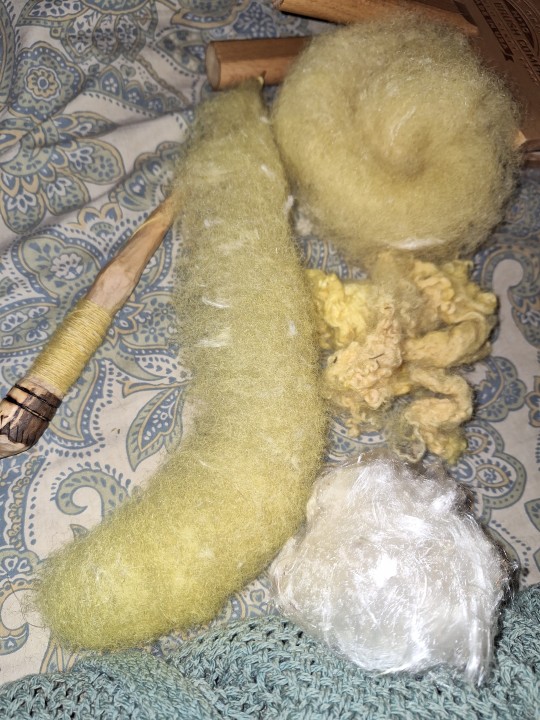
Sorry for the terrible lighting, but I have also been spinning a blend of some. This is ryå mixed with it--I've done two rolags so far, the first one with only a little milkweed and the second that about half and half, and they're both spinning up super well. They also mixed in very easily and obligingly.
Unfortunately woke up and the spindle tip had snapped, so I have to take a break while the glue dries.
#my bought spindle (the blue one with a captive whorl) also broke a few months back#and i went to fix it at the same time but the tip is no longer in the box. argh.#i might just whittle it shorter its already broken so many damn times#keeps breaking in new places too like its just too long and thin and weak to not shatter repeatedly#its actually broken more than any of my handmade spindles and i use it the least#so i think keeping the thin tip as short as is still comfortable to spin on might be key because most of my other spindles#have broken once if it at all#spinning#handspun yarn#milkweed#ryå lambswool#supported spindles#supported spinning#foraging
127 notes
·
View notes
Text
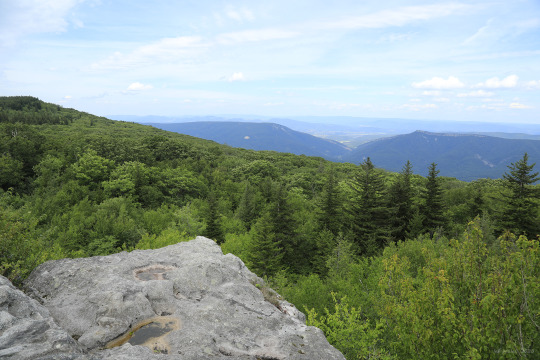
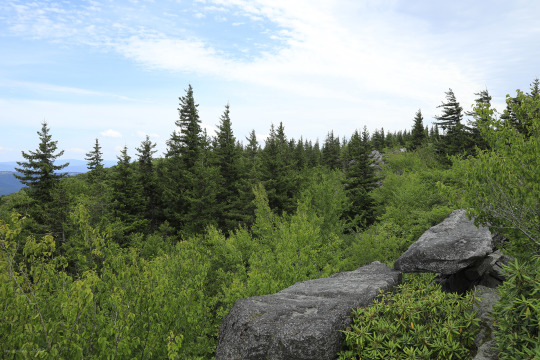



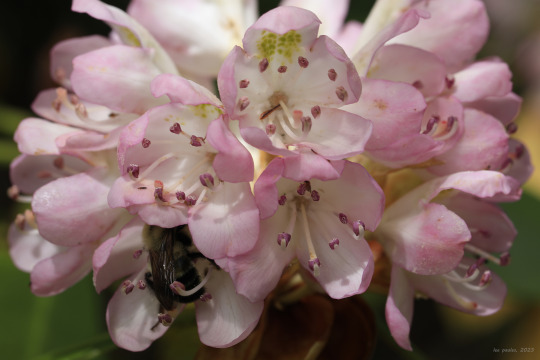

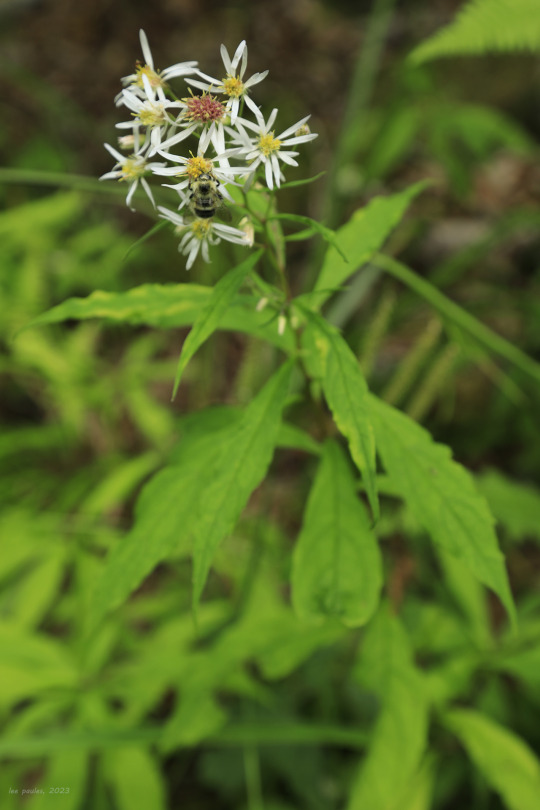





Hazy mid-summer day on the Sods, Part 2.
The planet's fantastic life energy reaches its peak in mid to late summer as the sun's precious light shrinks by the day and every living thing senses its time is running out. On the Plains of Dolly Sods, where the growing season is already compressed by the high elevation, plants compete for the swirling, buzzing masses of insects with their gaudy blooms and produce successive waves of berries to seed new generations. The drone of the insects carrying out their instinctive missions of renewal is constantly in your head as they dive and dart and skirt around you. You barely register as a distraction against the great drama playing out here - one whose stakes are survival, regeneration, salvation. I feel so privileged to have connected with this life force in the most intimate way, even for the few short years of my mayfly existence. I will die a happy man for having immersed myself in its lovely, purposeful chaos and becoming part of something much greater than myself.

#appalachia#vandalia#west virginia#wildflowers#flora#summer#allegheny mountains#monongahela national forest#dolly sods#common milkweed#great spangled fritillary#silver spotted skipper#great rhododendron#rosebay rhododendron#whorled aster#white snakeroot#black and yellow lichen moth#arabesque orb weaver#fireweed#mountain holly#catberry holly#spider#butterfly#moth#lepidoptera#bumblebee
74 notes
·
View notes
Text
I Got bored one time awhile ago and made a list of every prefix plus some into organised sections so I thought I might as well share.
All the ones that aren’t cannon to warriors, yet at lest are bold
Describing names
Colours: red, russet, copper, golden, amber, yellow, green, blue, violet, pink, white, gray, black, ebony, dark, pale, silver, brown, tawny, fallow
Pattern, Texture + Size: spot/ted, dapple, speckle, freckle, brindle, patch, mottle, ragged, tangle, kink, bristle, fuzzy, curl/y, wooly, soft, sleek, little, tiny, small, slight, short, tall, long, big, heavy, crooked, broken, half, stumpy, shred, torn, jagged
Actions + Character: flip, pounce, bounce, jump, hop, crouch, down, low, drift, flail, strike, running, fidget, mumble, whistle, snap, sneeze, shiver/ing, shining, flutter, fallen, lost, rush, fleet, quick, shy, sweet, brave, loud, quiet, wild, hope, wish,
Other: claw, whisker, dead, odd, one, spike, fringe, echo, song, hallow, haven
Elements
Time + Weather: day, night, dusk, dawn, morning, sky, sun/ny, moon, storm, lightning, thunder, cloud/y, mist/y, fog, snow, blizzard, ice, frost, dew, drizzle, rain, clear, wind, breeze, gale, shadow, shade, bright, light,
Earth/Water/Fire names: stone, rock, boulder, slate, flint, pebble, gravel, sand/y, dust, mud/dy, meadow, hill, rubble, river, ripple, whorl, float, rapid, shimmer, lake, swamp, marsh, wave, wet, bubbling, splash, puddle, pool, creek, fire, flame, flicker, flash, blaze, scorch, ember, spark, ash, soot, cinder, smoke
Plants
Trees: alder, aspen, birch, beech, cedar, cypress, pine, elm, willow, oak, larch, maple, bay, rowan, timber, bark, log, wood, twig, acorn, cone, seed, spire
Berry/Nut/Fruit/Herb: juniper, elder, sloe, holly, yew, mistle, bramble, hickory, hazel, chestnut, nut, apple, cherry, cranberry, olive, pear, plum, peach, chive, mint, fennel, sage, basil, mallow, parsley
Flowers: aster, poppy, primrose, rose, bluebell, marigold, tansy, pansy, briar, cherry, daisy, dandelion, daffodil, tulip, violet, lily, myrtle, thrift, yarrow, heather, lavender, blossom, bloom, flower, petal
Other: leaf, frond, fern, bracken, sorrel, hay, rye, oat, wheat, cotton, reed, pod, cinnamon, milkweed, grass, clover, weed, stem, sedge, gorse, furze, flax, nettle, thistle, ivy, moss, lichen, bush, vine, root, thorn, prickle, nectar
Animals
Mammals: mouse, rat, mole, vole, shrew, squirrel, hedgehog, bat, rabbit, hare, ferret, weasel, stoat, mink, marten, otter, hog, wolf, hound, fox, vixen, badger, deer, doe, stag, fawn, sheep, cow, pig, lion, tiger, leopard, lynx, milk
Birds: robin, jay, cardinal, thrush, sparrow, swallow, shrike, starling, rook, swift, dove, pigeon, crow, raven, duck, goose, heron, wren, finch, swan, stork, quail, gull, lark, owl, eagle, hawk, kestrel, buzzard, kite, hoot, feather, bird, egg, talon
Fish, Reptiles + Amphibians: pike, perch, pollack, trout, tench, cod, carp, bass, bream, eel, minnow, fin, snake, adder, lizard, turtle, frog, toad, newt
Bug type Names: bug, lady or ladybug, moth, spider, ant, snail, slug, beetle, bee, wasp, dragon or dragonfly, bumble, worm, maggot, cricket, fly, midge, web, honey
Skyclan + Warriorclan: Bella, Billy, Big, Harry, Harvey, Snook, Ebony, Monkey
71 notes
·
View notes
Text
Bergamot. Oak. Linen.
Three scent profiles that never meant much to you before he did.

Bergamot.
Eau Pour Le Jeune Homme, Maitre Parfumeur et Gantier.
Top: Orange, bergamot.
Middle: Nutmeg, coriander.
Base: Sandalwood.
Like lazing across from each other at the dinner table. Steam billowing over mugs of earl gray tea, cookies that one of the nice old women in town had shoved into your hands just earlier that day stacked haphazardly on a plate between the two of you. Clear vase of purple catmint, yellow coneflowers, and whorled milkweed sitting at the end of the table runner to your left.
His chuckle turns into a snort as he scribbles onto a sticky note, peeling it back and slapping it down next to your mug as he turns his attention back to his phone. He's been doing this the entire time you two settled down at the table. You regret influencing his Instagram algorithm. Messy blue ink sprawls out the yellow piece of paper.
betray, belittle, boytoy
Oak.
Gentleman Reserve Privée, Givenchy.
Top: Bergamot.
Middle: Chestnut.
Base: Whiskey, amber.
Like special occasions. You sit on the bed, watching him rubber band between the bathroom and the bedroom to get ready to leave. You've been ready for at least ten minutes, but he insists on looking his best for this party your parents were throwing, and that meant rummaging through his fancy fragrances. He's never overbearing with it- always just enough cling to him and his clothes. Neck, inner elbows, wrists- always, like clockwork.
He has no idea what the fancy words on the bottles mean, but he does know that he doesn't want to smell like anything resembling 'toilet', so eau de parfum is the next best thing. You can catch wafts of it lingering in the air as he moves, before he finally stands proudly before you, hands on his hips, and a proud wide-toothed smile on his face.
"Y'ready?"
Linen.
Lin Blanc, Jeanne en Provence.
Top: White flowers, pear.
Middle: Lavender, cotton.
Base: Vanilla, white woods.
Like freshly dried sheets. He dedicates Sunday to laundry day. The washer and dryer in the house are still pretty new and practically pristine, but he will always air out and pin up the bedsheets and pillowcases on the clothesline like Ma did when he was younger. It makes him feel better to shake them out and flatten them out against the line outside in the backyard- nostalgic, really.
Sometimes he lays down in the grass beneath them after a few hours. He stares up at the bright blue sky. Sheets dance along the cool breeze, like the fluttering fabric of a waltz. You watch curiously through the window the first few times, and eventually, you convince yourself to go outside and lay next to him.
And he welcomes you happily.
"That cloud looks like a cow."
Bonus.
The Most Wanted, Azzaro.
Top: Cardamom.
Middle: Toffee.
Base: Amberwood.
He pulled the bottle out of the box and buried it in his sock drawer in the walk-in closet. You're half sure he got it just because it looks like a revolver cylinder. You've test-sprayed it on your wrist before- sickly sweet caramel, strangely spiced- and you scrunched your nose at it. He laughed from the doorway.
It was supposed to "settle," he had said. Whatever that means. It had been maybe a month since he hid it away, so imagine your surprise when he finally pulls the bottle out. You cringe a little as you recall the scent while he mists it onto the collar of his button down, watching the fragrance just hook onto the fabric. He chuckles at your expression as he affixes one of his watches to his wrist. You take a half step back as he comes towards you, but the smell isn't nearly half as bad nor domineering as it first was- suddenly subtly sweet and tangy. He simpered as your expression mellowed.
"Better now, ain't it?"

Babes that wanted to be tagged:
@mockerycrow @kivino
#Rancher AU#Graves.#Mini.#Been on a perfume kick recently idk.#Dawg said “Toilet?? Oh hell naw.”#Had to post it or else it wouldve never seen the light of day.#It's been sitting in my drafts for TWO WEEKS.#Phillip Graves x Reader#Phillip Graves x gn!Reader#cod mw2#cod mwii#Phillip Graves
46 notes
·
View notes
Note
ive done some spinning with milkweed fluff!! it stayed together but i had to keep it super wet to do the actual spinning. i made it into a little square and its so soft and fluffy!! but yes its very difficult to spin as the fibres are very short [i spin with a top whorl drop spindle]
Oooh, cool! Honestly I feel you're not the first person I've heard of on Tumblr spinning milkweed fluff, which makes it feel all the more wild that most online sites that mention it say its impossible???? Wild.
Out of curiosity, asides from the square, what would you find spun milkweed useful for making? I ask this not as someone who's ever spun thread or someone interested in taking it up, just as a curious passerby lol.
#out of queue#ani rambles#answered asks#this ask has been sitting in this inbox for a hot minute now and I Kept Forgetting To Answer It#I'm 90% positive its in response to my 'how to collect milkweed seeds without the fluff' post#bc i mentioned in the tag that i saw people spinning but all the online sources I stumble across when searching stuff#say 'oh its too brittle to be spun'#maybe its because a lot of the sources I'm looking at are focused on the gardening/growing of milkweed and not like#making cordage out of it or spinning the fibers or anything like that. different worlds I guess.#i have rambled on in the tags long enough so allow me to just say#i think its cool as hell that you're spinning milkweed fibers you go you funky little pogchamp you
13 notes
·
View notes
Photo


Little umbels of consistent white dot the logging road in shaded transitional forbe mosaics as June leaves May behind. Lucky, always lucky to see, four leaves in a whorl. Shade tolerant milkweed, the earliest woodland Asclepias. Here I struggle to get lighting for the shots as mixed mesophytic transitions to alkaline mesic hillside; both hydrology, soil chemistry change as a hidden ecotone in the woods shows it’s self through it’s subtlety.
Asclepias quadrifolia,
Four leaf milkweed.
30 notes
·
View notes
Text
Ok, so I know I said I was going to use my native pollinator grant to fix my very sad and pathetic looking front "lawn."
But, we have this other issue.
We realized, a few months after buying Rhombus house, that the dining room was a sunroom that somebody had slapped some drywall on.
There is no. Insulation, Under. The Floor. Just 18 empty inches over bare frozen ground.
I live in Minnesota. It gets to -40 on the regular. Our heat bills last winter were ghastly.
We were going to dig under and insulate, but that is turning out to be just too cost prohibitive.
What does this have to do with my garden plans?
A cubic foot of soil has an r value (an insulation measurement) of 9. That's getting close to half of the insulation we need. We're going to do more, inside, but adding raised beds around the dining room, that insulates the air under the room, is going to be integral to making that room livable and lowering our energy costs.
Our grant allows us to spend up to 30% of our budget on things other than plants. That won't cover the cost of all that sand and dirt, but it'll take a nice big chunk out of the cost for us.
So, the front yard will have to remain sad. We have fuel usage to reduce.
The new plan is a raised bed on two sides. One side is sunny, and will have blue and white indigo, a couple types of asters, red marsh and white whorled milkweed, Ohio spiderwort, virgin's bower (a native climbing clematis), and woodland phlox. Then, we'll plant a row of native lowbush blueberries in front of that to disguise the box and make the whole thing look a bit grander. I'm planning on somewhat symmetrical planting to make sure it all looks like really deliberate planting. Really mix that Victorian formal and prairie planting vibes.
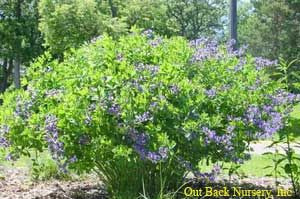

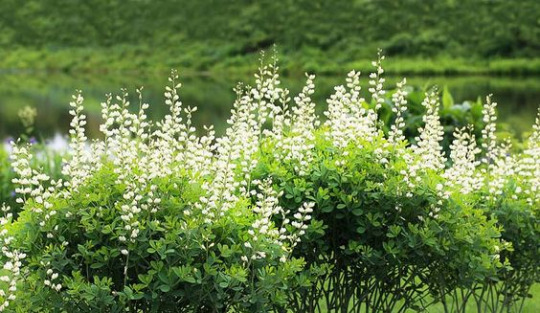

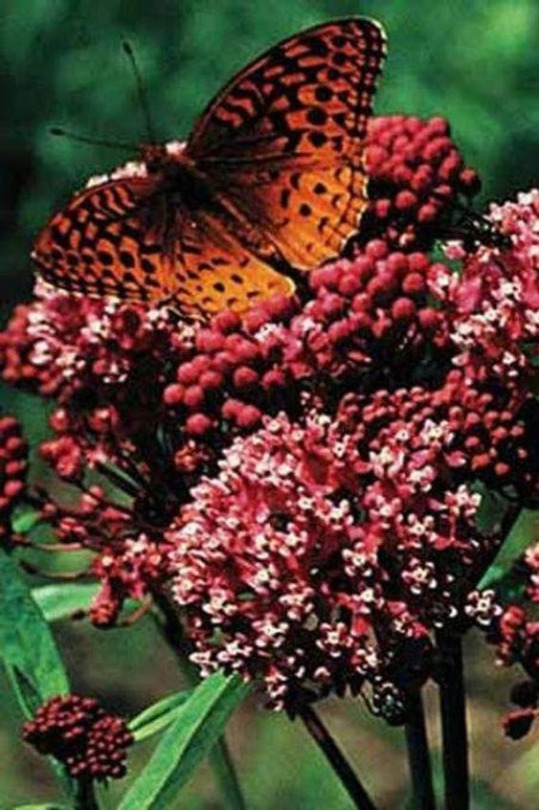


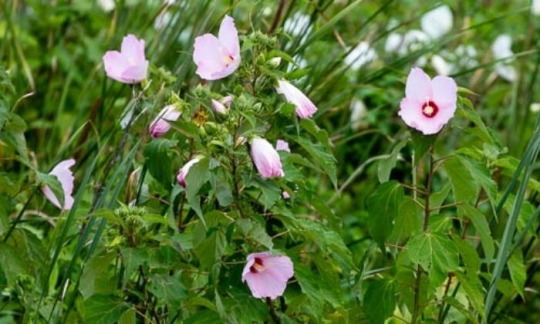
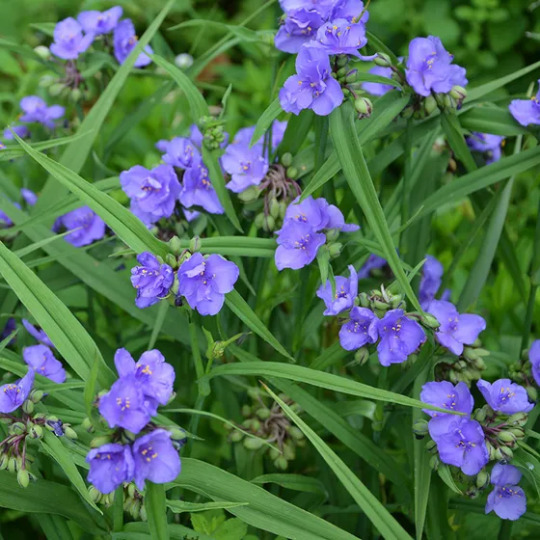
The end result will have multiple pollen sources for pollinators, available from April right through to October, and should be pretty low maintenance.
The side with more shade, that you don't usually see, we're giving over to native raspberries, blackberries, thimbleberries, and spikenard. Which means they're going to have to be separate beds up next to each other so these rhyzomus berry brambles have a slightly harder time devouring everything around them.
Should lead to some fun jams in the future, and very happy birds.
19 notes
·
View notes
Text
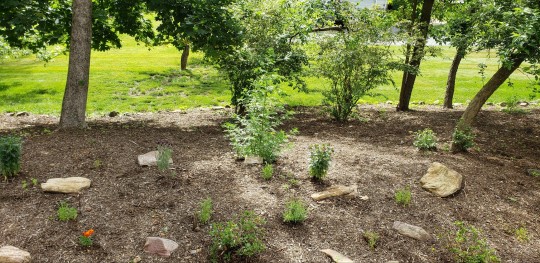



My Side Garden Over 4 Years
In 2019 the last of the 15 Ash Trees adjacent to my mother's home were taken out and I had decided to garden now that I had access to a yard again. The soil here is very rocky, prior to being constructed the side of this yard was a forest on the property line of a farm, that's why our ash were massive before they succumb to the borer.
The first year I planted some Perennials from a box-store and threw a random 'wildflower' seed mix in and unsurprisingly most of them died (although sweet-williams and cornflower persist which is fine with me)
The next year a whole bunch of annual cosmos and Zinnia took over but the only surviving perennials were native plants, after that I got more into native plants and got some native seeds from an adjacent field, Prairie Moon, and the forest that I spread. Then I got some native perennials from a local grower or took some divisions from my aunt (and grew some marigolds to keep the deer away).
The next year everything established and I did a layer of mulch over leaf litter to improve the soil a little, I discovered that in the coming drought this retained a decent amount of moisture for my young plants, I also noticed the diversity of insects and bird life that these plants brought. Our Yard was the only one with monarch caterpillars, constantly churning with butterflies, I noticed all new stingless bee species I'd never seen before, so many fascinating native fauna that never had decent habitat prior to this. I convinced the rest of my family to change their ways, less lawn, no pesticides at all, and less aggressive maintenance (I still weed but not as much because the perennials block out a lot of new growth). I noticed something else, fireflies I had grown up seeing were disappearing around the neighborhood, but not in this yard, because we had provided that proper leaf layer habitat for these fireflies, they were extremely abundant in our patch of garden. all the other neighbors who poison their gardens and heavily maintain lawns had nothing lighting up around them.
I'm studying in Landscape Architecture, work in architecture currently, my gardens look horrible because to me they are an opportunity to learn how plants grow. This year I made sure to keep leaf layer untouched in the hopes I could keep the fireflies, the garden looks really full even with little rain this may! it doesn't look perfect but the garden is more for ecosystem value (albeit rather small but to expand upon existing field nearby).
I try to plant things that I've seen growing wild locally, local natives in my garden as seen above include: Joe Pye Weed, Blueberry bush (highbush), Common Milkweed, Swamp Rose Milkweed, Butterfly Weed (ascelpias tuberosa), Columbines, White Snakeroot, spicebush, elderberry (this one is small in this garden), wild bergamot, various aster species, anise hyssop, and a tulip poplar sapling :)
Natives that are within this ecological region but not common to my area: blazing star, prairie blazing star, False Indigo, Blue flag Iris, Black eye'd Susan's, purple coneflower, obedient plant, Prairie dropseed, palm sedge, various sunflower species, bee balm, st. John's wort, whorled milkweed, various azaeleas, tickseed, eastern bluestar, Blue lobelia, and a persimmon tree
Nonnatives that do well and don't compete: English lavender, sweet Williams, 'Shasta' daisies, rocket larkspur, astilbes, cosmos (self seeding), tea rose, various herbs and annuals I throw in there like sunflowers, corn, amaranth.
15 notes
·
View notes
Text
Note to Self: Oklahoma Milkweeds
Asclepias Incarnata (Swamp Milkweed)
Asclepias Syriaca (Common Milkweed)
Asclepias Tuberosa (Butterfly Weed)
Asclepias Verticillata (Whorled Milkweed)
Asclepias Amplexicaulis (Sand Milkweed)
1 note
·
View note
Text



My first attempts at embroidering flowers (or anything) The one next to the blue rose is supposed to be whorled milkweed but Im not sure I captured it
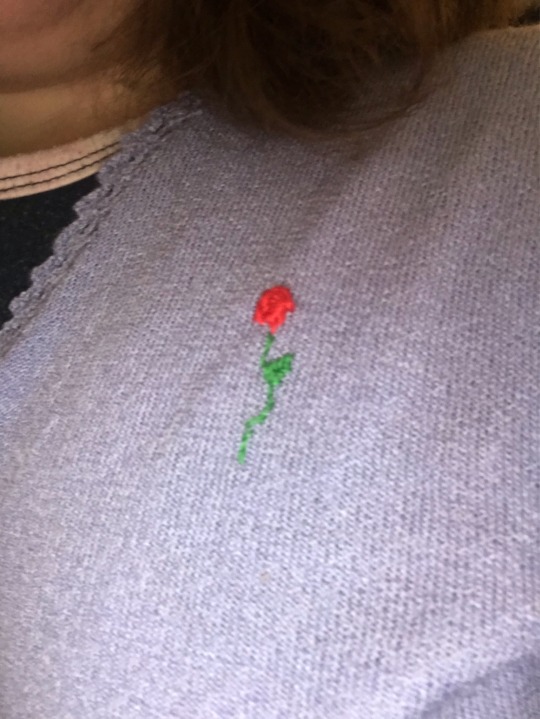
2 notes
·
View notes
Text


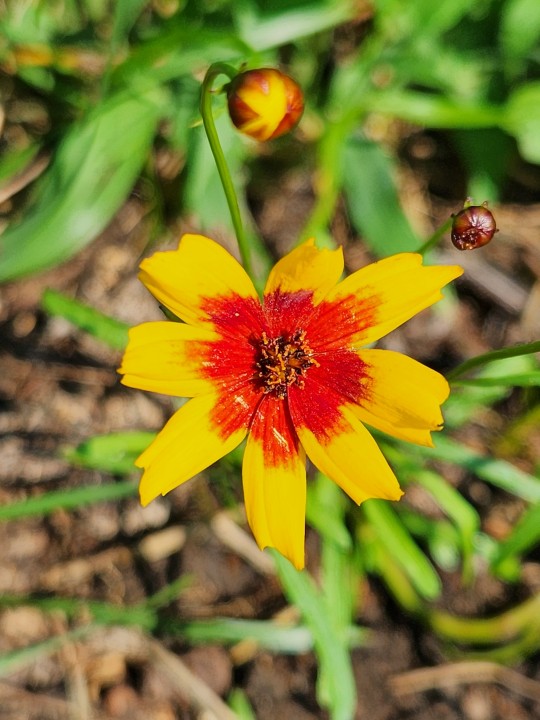


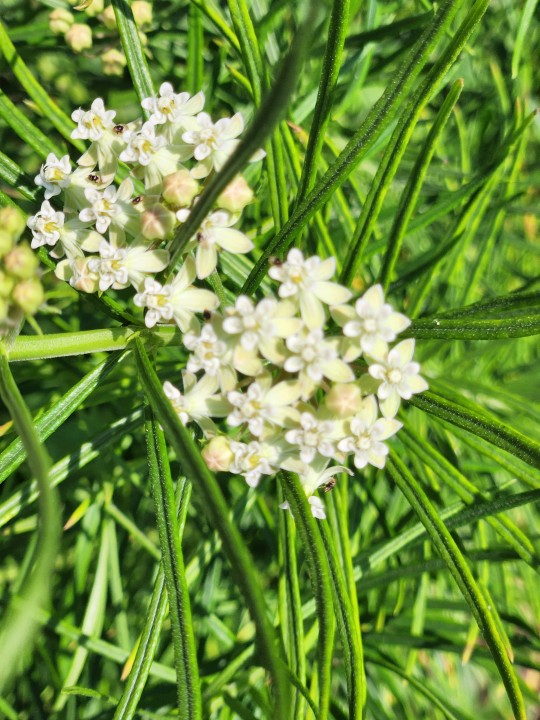



Floral fireworks from today's garden. The coreopsis are really starting to take off! And the whorled milkweed (the white flowers) has finally bloomed!
43 notes
·
View notes
Text
Three of my corn plants are making flowers! They’re actually quite elegant plants in a garden setting, by the way. I recommend corn as a garden annual that you just so happen to get delicious treat out of. Plant them sporadically amongst other sun-loving plants of differing heights, spreads, and leaf shape and they’re very nice. I have them interspersed between my wild geranium, purple poppymallow, fireweed, rattlesnake master, purslane, smooth rose, chives, redroot amaranth, anise hyssop, field thistle, compass plant, Canada milk vetch, rough blazing star, and firewheel.
My whorled milkweed is also making flowers, my devil’s tongue cactus is in bloom, my cranberry is making exactly two cranberries, and my clammy groundcherry’s flowers are beginning to go to fruit! My sweet joepyeweed has grown up very tall this year and is making flowers too. My common milkweed is in bloom and smells absolutely heavenly. I don’t think I’d noticed the smell before but I got a whiff of it when I was checking up on that part of the garden, and had to put my nose to several of my plants in bloom until I got to the milkweed. Lovely.
I ate the first of many black raspberries. That one has made a very tall growing cane this year which I know is going to arch over at some point. It was very sneaky last year and managed to make two more of itself despite my efforts (trust me, you don’t want an overgrown raspberry patch), but I’m not going to let it this time. One of my maypops is almost long enough to try and train to grow up the dead pine tree that it is refusing to grow up on its own.
5 notes
·
View notes
Text
Summer Wild Flowers! (Wetlands)
Hey, haven’t done one o’ these in a while. Had a nice hike over the wetlands and fields. Here are some common and rare wild flowers you can find (in mid/north eastern USA)
-------------------------
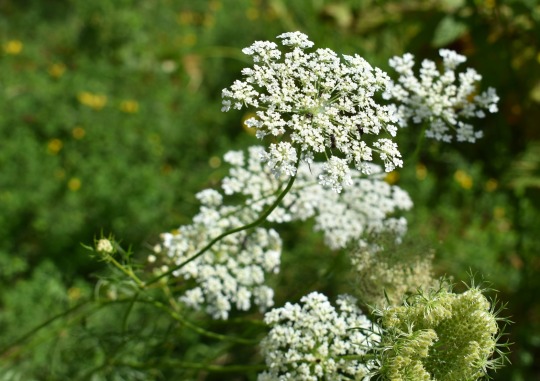
Queen Anne’s Lace (or Wild Carrot)
Very common in fields and on road sides. Attracts many pollinators, but those with sensitive skin can get rashes when handling the raw plant. The ‘basket’ of flowers are much more dense than its bad relatives (water and poison hemlock) and also has the tell tale red/purple dot at the center.
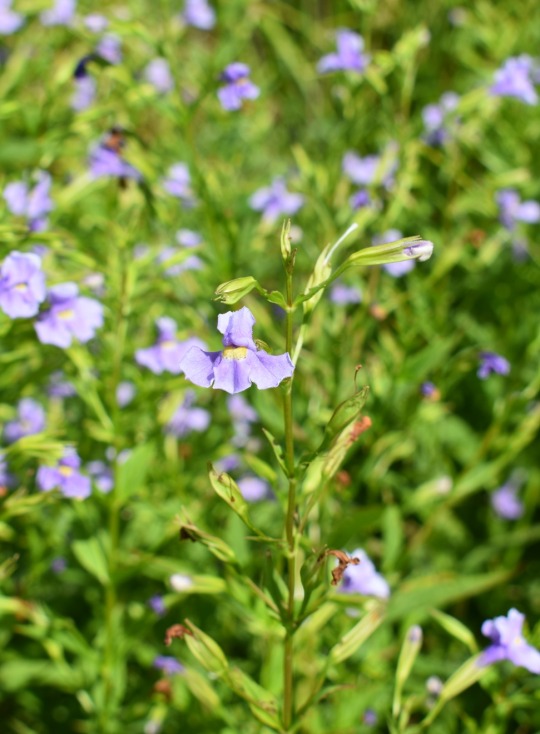
Monkey Flower
The mature flower is supposed to look like a monkey’s head (I don’t see it). Grows in little colonies and likes wet open fields. Is actually considered endangered in many areas.
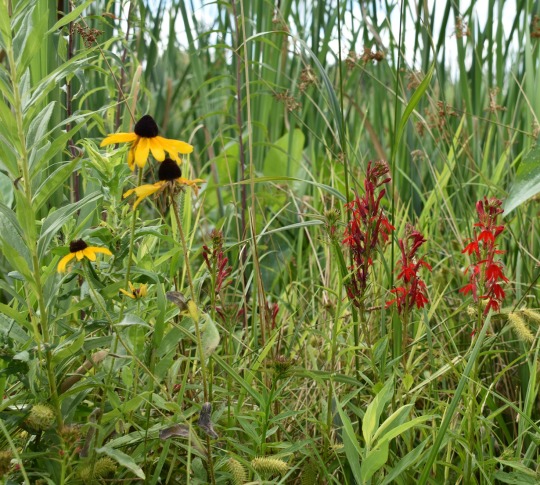
Cardinal Flower (with Black Eyed Susans and Cat Tails)
A striking wild flower with nothing coming close to its bold red color. Good for attracting butterflies, however it is rather rare in public areas due to humans picking it because of its unique look.

Swamp Milkweed
There are three main milkweeds in this area but this one flowers last. Also known as Narrow Leaf, I believe. Amazing food source for pollinators in wetlands. Easy way to tell a milk weed is to rip off a tip of a leaf - if a milky white sap comes out, it’s probably a milkweed.

Joe Pye Weed
A bold and very tall field and wetland plant. Loved by butterflies (that’s a Tiger Swallow Tail). Seen as a cumbersome weed in larger properties so it can become rare. Grows very tall (10 feet) and one of the few tall plants with a whorled leaf pattern.
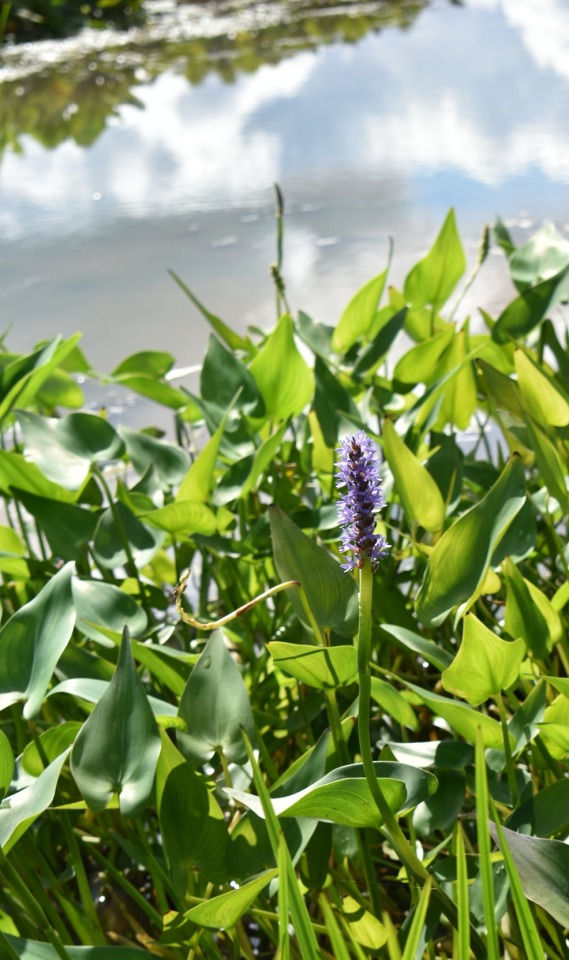
Pickerelweed
There are quite a fer large, showy water plants that will grow in shallow wetlands or along small lakes or streams. Arrow Weed looks very similar but has a small white flower, Spadder Dock has much broader leaves and a pod like yellow flower. Other water plants such as lilies have more flat flowers. Pickerelweed is the most bold with a series of tall stalks of purple flowers. Even birds will feed from it!
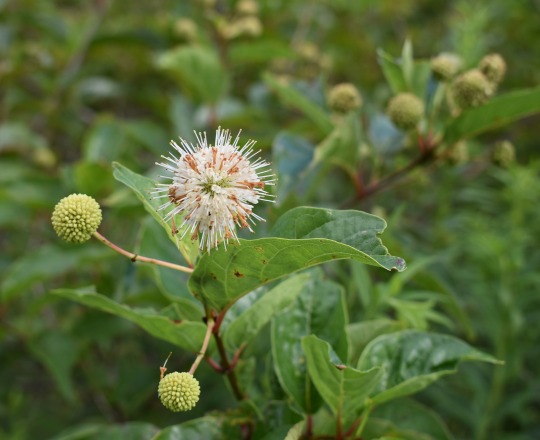
Button Bush
Ok, I cheated. This is a water loving bush. Called the Covid Flower by my mom, the Button Bush has cute spherical flowers that pop up all over the ends of the branches. Common and beautiful.

Chicory
A weed you will see on the sides of roads and in fields or waste sites in abundance. Pretty easy to ID due to it being a thick ‘stem’ with a series of light purple flowers and not really any large leaves. This weed has a secret as all of it is edible and can be used to help with various medical issues.
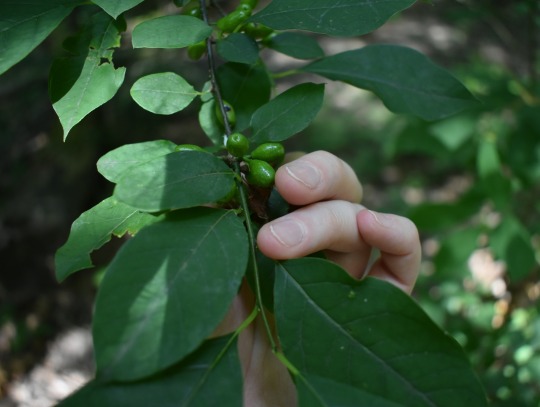
Spice Bush (female)
Aaaand another bush! My favorite! The only common alternate leaved bush in the area, the Spice Bush can either be male or female, with the female growing flowers and eventually berries that go from green to red. Said berries can be pitted and dried and crushed to make an allspice like powder. The leaves also have the wonderful smell too! Fairly common and easy to ID due to the bright stems on the leaves.
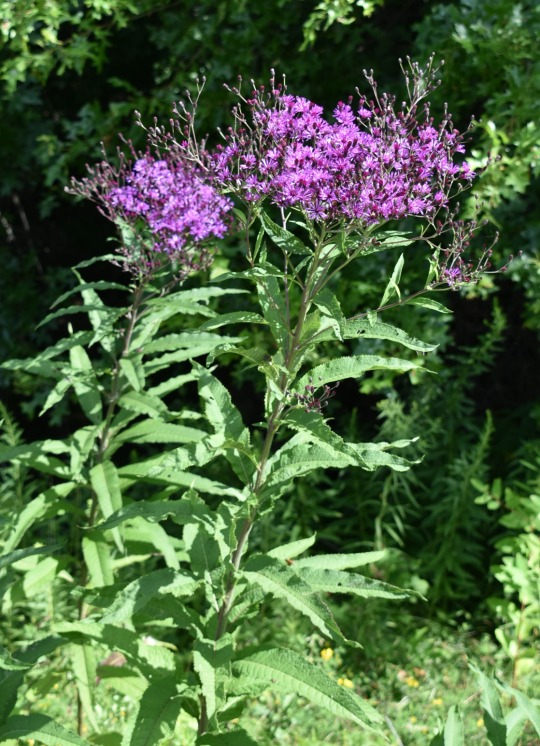
Tall Iron Weed
This field plant can grow up to 10 feet tall. Similar to Joe Pye Weed but with a different leaf pattern. Also loved by butterflies and bees. Will grow in clumps. Also sees as an annoying weed in fields and large properties, but flourishes in parks.
#plants#nature#wetlands#iron weed#joe pye weed#wild carrot#i didnt get any blazing star#this is an incomplete list#i will find more#weee
5 notes
·
View notes
Text

FLP CHAPBOOK OF THE DAY: Hard Feelings by Elizabeth R. McCarthy
On SALE now! Pre-order Price Guarantee: https://www.finishinglinepress.com/product/hard-feelings-by-elizabeth-r-mccarthy/
Elizabeth McCarthy lives in northern Vermont with her husband. She self-published her first poetry chapbook The Old House in 2020, and her second chapbook, Winter Vole was published by Finishing Line Press in 2022. Elizabeth’s poems appear in several magazines and literary reviews such as; The Washington Post, The Main Street Rag, Silver Birch Press, Blue Heron Review and many others. Elizabeth is a member of the Poetry Society of Vermont and an online member of The Lockdown Poets of Aberdeen, Scotland. #poetry #Vermont #nature
PRAISE FOR Hard Feelings by Elizabeth R. McCarthy
Hard Feelings, Elizabeth McCarthy’s second poetry collection, is filled with close observations of birds and other wildlife found in the Vermont countryside. Through metaphor and simile, form and imagination, the poet transforms these observations into the language of poetry. In the title poem, the last wild apples of the season are likened to grudges that linger and ferment, becoming “sour little/hearts that/rot in place.” In “Scuttled Memories,” an extended maritime metaphor evokes the sense of time passing when we leave our grief and regrets “stuck in the wooden hull/of memory.” Yet these are ultimately celebratory poems, full of the joy of discovery, like the old milkweed seeds that “burst open/the pod door — escaping/to whorl and dance/in the autumn sun.”
–Angela Patten, author of The Oriole & the Ovenbird, In Praise of Usefulness and other books.
In Elizabeth McCarthy’s beautiful, new collection, Hard Feelings, we enter a world of sandhill cranes, field crickets, spring peepers, odd cats, and cleansing rain. Present and thankful for ordinary moments, McCarthy shares her deep connection to nature and the whispered wisdom she receives. She speaks to us of her preferred world, “where understanding / is the sunrise.” Reverently hanging items of laundry in the summer sun, McCarthy writes about, “pinning them in silent prayer,” and we experience the day through her appreciative eyes. These are poems that offer solace, even when processing grief. Above all else, these are poems of hope, “for those who / believe in destiny / delivered in the night / of each new month.”
—Cristina M. R. Norcross, Founding Editor of Blue Heron Review; author of The Sound of a Collective Pulse and other titles
Please share/please repost #flpauthor #preorder #AwesomeCoverArt #poetry #chapbook #read #poems
#poetry#flp authors#preorder#flp#poets on tumblr#american poets#chapbook#chapbooks#finishing line press#small press
0 notes
Text
Asclepias verticillata (whorled milkweed), Vincent van Gogh (Dutch, 1853–90), Wheatfield under Thunderclouds, 1890, Van Gogh Museum., Richard Gerstl (Austrian, 1883–1908), Lakeside Road near Gmunden, 1907, Leopold Museum, Vienna, Neue Galerie New York., medical problems of the suicide, I Will Boast In Christ - Hillsong Worship, “What can wash away my sin, Nothing but the blood of Jesus, What can make me whole again, Nothing but the blood of Jesus”
Asclepias verticillata (whorled milkweed), Vincent van Gogh (Dutch, 1853–90), Wheatfield under Thunderclouds, 1890, Van Gogh Museum., Richard Gerstl (Austrian, 1883–1908), Lakeside Road near Gmunden, 1907, Leopold Museum, Vienna, Neue Galerie New York., medical problems of the suicide, I Will Boast In Christ - Hillsong Worship, “What can wash away my sin, Nothing but the blood of Jesus, What can make me whole again, Nothing but the blood of Jesus”
https://blog.naver.com/artnouveau19/222865991059
https://en.wikipedia.org/wiki/Asclepias_verticillata
https://www.facebook.com/VanGoghMuseum/photos/a.179281710596/10166932216500597/
https://www.facebook.com/neuegalerieny/photos/a.10151015807910822/10159832802440822/
https://youtu.be/h_dsUhYUqwc
Asclepias verticillata, the whorled milkweed, eastern whorled milkweed, or horsetail milkweed, is a species of milkweed native to most of eastern North America and parts of western Canada and the United States.
https://en.wikipedia.org/wiki/Asclepias_verticillata
Van Gogh Museum
What do you feel when you look at this painting?
‘I’d almost believe that these canvases will tell you what I can’t say in words, what I consider healthy and fortifying about the countryside’, wrote Vincent to his brother Theo. This is one of the landscapes of the wheatfields around Auvers that Vincent made in the last weeks of his life.
Vincent van Gogh, Wheatfield under Thunderclouds (1890)
https://www.facebook.com/VanGoghMuseum/photos/a.179281710596/10166932216500597/
Vincent Willem van Gogh (Dutch: [ˈvɪnsɛnt ˈʋɪləɱ vɑŋ ˈɣɔx] (listen);[note 1] 30 March 1853 – 29 July 1890) was a Dutch Post-Impressionist painter who posthumously became one of the most famous and influential figures in Western art history. In a decade, he created about 2,100 artworks, including around 860 oil paintings, most of which date from the last two years of his life. They include landscapes, still lifes, portraits, and self-portraits, and are characterised by bold colours and dramatic, impulsive and expressive brushwork that contributed to the foundations of modern art. He was not commercially successful and, struggling with severe depression and poverty, committed suicide at the age of 37.
https://en.wikipedia.org/wiki/Vincent_van_Gogh
Neue Galerie New York
This #LaborDayWeekend we’re dreaming of balmy days spent under the trees.
Richard Gerstl spent a few summer holidays in Gmunden, a picturesque spa town south of Salzburg on the Traunsee. While there, Gerstl painted at least fifteen landscapes en plein air. They are loosely executed with heavy impasto, and are redolent with “loops, strokes, spots, spirals, and whorls.” Captivated by the verdant landscape, Gerstl turned out scenes of gardens and fruit trees burgeoning with ripe fruit. These exceptional landscapes capture the lush beauty of a summer day.
________
Richard Gerstl, “Lakeside Road near Gmunden,” 1907, oil on canvas. Leopold Museum, Vienna
#NeueGalerie
#NeueGalerieNY
https://www.facebook.com/neuegalerieny/photos/a.10151015807910822/10159832802440822/
Richard Gerstl (14 September 1883 – 4 November 1908) was an Austrian painter and draughtsman known for his expressive psychologically insightful portraits, his lack of critical acclaim during his lifetime, and his affair with the wife of Arnold Schoenberg which led to his suicide.
https://en.wikipedia.org/wiki/Richard_Gerstl
I Will Boast In Christ - Hillsong Worship
https://youtu.be/h_dsUhYUqwc
5,331,383 views Dec 9, 2016
Hillsong Worship
8.44M subscribers
SUBSCRIBE
"I Will Boast In Christ" from our album 'let there be light' recorded live at Hillsong Conference in Sydney, Australia.
1 note
·
View note